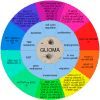Long Non-Coding RNAs in Gliomas: From Molecular Pathology to Diagnostic Biomarkers and Therapeutic Targets
- PMID: 30217088
- PMCID: PMC6163683
- DOI: 10.3390/ijms19092754
Long Non-Coding RNAs in Gliomas: From Molecular Pathology to Diagnostic Biomarkers and Therapeutic Targets
Abstract
Gliomas are the most common malignancies of the central nervous system. Because of tumor localization and the biological behavior of tumor cells, gliomas are characterized by very poor prognosis. Despite significant efforts that have gone into glioma research in recent years, the therapeutic efficacy of available treatment options is still limited, and only a few clinically usable diagnostic biomarkers are available. More and more studies suggest non-coding RNAs to be promising diagnostic biomarkers and therapeutic targets in many cancers, including gliomas. One of the largest groups of these molecules is long non-coding RNAs (lncRNAs). LncRNAs show promising potential because of their unique tissue expression patterns and regulatory functions in cancer cells. Understanding the role of lncRNAs in gliomas may lead to discovery of the novel molecular mechanisms behind glioma biological features. It may also enable development of new solutions to overcome the greatest obstacles in therapy of glioma patients. In this review, we summarize the current knowledge about lncRNAs and their involvement in the molecular pathology of gliomas. A conclusion follows that these RNAs show great potential to serve as powerful diagnostic, prognostic, and predictive biomarkers as well as therapeutic targets.
Keywords: biomarker; diagnosis; glioblastoma; glioma; long non-coding RNA; molecular pathology; prognosis.
Conflict of interest statement
The authors declare no conflicts of interest.
Figures
Similar articles
-
Long non-coding RNAs: potential molecular biomarkers for gliomas diagnosis and prognosis.Rev Neurosci. 2017 May 24;28(4):375-380. doi: 10.1515/revneuro-2016-0066. Rev Neurosci. 2017. PMID: 28107175 Review.
-
Long non-coding RNAs in glioma progression.Cancer Lett. 2018 Apr 10;419:203-209. doi: 10.1016/j.canlet.2018.01.041. Epub 2018 Jan 31. Cancer Lett. 2018. PMID: 29355660 Review.
-
Long non-coding RNAs as potential biomarkers and therapeutic targets for gliomas.Med Hypotheses. 2013 Aug;81(2):319-21. doi: 10.1016/j.mehy.2013.04.010. Epub 2013 May 18. Med Hypotheses. 2013. PMID: 23688743
-
A critical overview of long non-coding RNA in glioma etiology 2016: an update.Tumour Biol. 2016 Nov;37(11):14403-14413. doi: 10.1007/s13277-016-5307-4. Epub 2016 Sep 15. Tumour Biol. 2016. PMID: 27629290 Review.
-
New insights into long noncoding RNAs and their roles in glioma.Mol Cancer. 2018 Feb 19;17(1):61. doi: 10.1186/s12943-018-0812-2. Mol Cancer. 2018. PMID: 29458374 Free PMC article. Review.
Cited by
-
Production and Stabilization of Specific Upregulated Long Noncoding RNA HOXD-AS2 in Glioblastomas Are Mediated by TFE3 and miR-661, Respectively.Int J Mol Sci. 2022 Mar 4;23(5):2828. doi: 10.3390/ijms23052828. Int J Mol Sci. 2022. PMID: 35269968 Free PMC article.
-
Cuproptosis-related ceRNA axis triggers cell proliferation and cell cycle through CBX2 in lung adenocarcinoma.BMC Pulm Med. 2024 Feb 14;24(1):85. doi: 10.1186/s12890-024-02887-0. BMC Pulm Med. 2024. PMID: 38355480 Free PMC article.
-
Deciphering the enigma: long noncoding RNAs in disease pathogenesis and therapeutic prospects.Mol Cell Biochem. 2025 Aug 14. doi: 10.1007/s11010-025-05368-y. Online ahead of print. Mol Cell Biochem. 2025. PMID: 40810918 Review.
-
Glioblastoma stem cells and Wnt signaling pathway: molecular mechanisms and therapeutic targets.Chin Neurosurg J. 2020 Aug 3;6:25. doi: 10.1186/s41016-020-00207-z. eCollection 2020. Chin Neurosurg J. 2020. PMID: 32922954 Free PMC article. Review.
-
Long Non-Coding RNAs: New Insights in Neurodegenerative Diseases.Int J Mol Sci. 2024 Feb 14;25(4):2268. doi: 10.3390/ijms25042268. Int J Mol Sci. 2024. PMID: 38396946 Free PMC article. Review.
References
-
- Louis D.N., Perry A., Reifenberger G., von Deimling A., Figarella-Branger D., Cavenee W.K., Ohgaki H., Wiestler O.D., Kleihues P., Ellison D.W. The 2016 World Health Organization Classification of Tumors of the Central Nervous System: A summary. Acta Neuropathol. 2016;131:803–820. doi: 10.1007/s00401-016-1545-1. - DOI - PubMed
-
- Miller C.R., Perry A. Glioblastoma. Arch. Pathol. Lab. Med. 2007;131:397–406. - PubMed
Publication types
MeSH terms
Substances
LinkOut - more resources
Full Text Sources
Other Literature Sources


 , oncogenic…
, oncogenic…  , tumor suppressor lncRNAs).
, tumor suppressor lncRNAs).